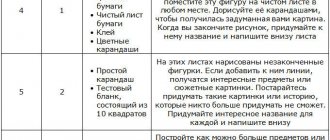KMS thinking model
Visual thinking is just one way of thinking. To explain the approach to training such thinking, let's look at one of the interpretations of the description of the thinking process. I called this interpretation the KMS model of thinking (Kishmish, Thoughts, Structure).
What happens in our heads can be divided into two main processes: unconscious and conscious. What happens in the unconscious is not always clear, but it certainly works. There are scraps of knowledge, images and much more wandering around there. In our model, let's call this part of thinking Kishmish.
The unconscious part of the CCM model. It's all Kishmish and it's scary to look there.
Already conscious thoughts appear in the conscious part, so the second part of the model is simply called Thoughts. Since we are accustomed to thinking in words, thoughts can appear in the form of thought words. And also, in the form of other various thought forms. For example, artists and architects can think in images, but for mathematicians, thought forms appear immediately in the form of mathematical formulas. So it turns out that in our heads there is a constant interaction between the unconscious and the conscious.
The unconscious and conscious parts are in the head. The interaction never stops. Thoughts are generated constantly.
But no matter what thought forms our thoughts manifest in the conscious part, there is always a problem - to keep them in the head, to build logic, to connect them into some kind of structure. To do this, you need to somehow fix them outside the head. This is where the third part of the model appears, called Structure. Working with the Structure also triggers some processes in the unconscious. And it turns out to be a kind of closed thinking process between three parts: Kishmish - Thoughts - Structure.
Triune model of thinking. Fixation in the physical world helps to catch thoughts.
Structure can be called any form of holding thoughts and building some logic for their presentation. For example, Structure can be our speech and written text. Translating thoughts into visual images and assembling them into a visual composition is also a structuring process.
The structure can be text (speech) and composition of visual objects
The definition of visual thinking can be formulated as follows.
Visual thinking is working with visual objects (images, signs), replacing work with real objects. By operating with visual images, you can structure and visually interpret your thoughts. Or visually package meanings to convey and explain them.
Within the framework of the KMS model, visual thinking is formed when thoughts are structured immediately into images (MS segment). And the difficulty of pumping it up is that for us this process is very unusual and inconvenient. Those. To directly translate thoughts into images you need to work hard. And the brain doesn’t really like to strain 
Visual thinking is when thoughts immediately turn into images
In the practice of Smyslotheka, we were faced with the question: How to improve the visual thinking of our artists? And it was the practice of answering this question that showed that it is easier to train based on the structure of the texts.
General results
In general, the visualization process can be divided into 5 steps:
- A clear goal and a detailed image of what you want. In this case, you need to determine where the desire comes from: from the soul or from society. If there is even a slight discomfort and there is no joy, the desire is from society; if there is a feeling of lightness, joy and happiness, the desire is from the heart.
- Visualization of the image and writing it down on paper in all details.
- Letting go of the image, after which we forget about the desire.
- Action.
- Accepted with gratitude.
Visualization is a creative process and there is no ideal algorithm for this process for all people. Everything is individual and each person may have their own adjustments.
I recommend: Materialization of thoughts. Managing life through the power of thought.
Visualization through synchronization by meaning
The training process is as follows. To visualize the meaning of a text, we have to work not with the text itself, but with the field of meanings of this text. After all, different people have different concepts, contexts and meanings behind the same words. In my visual thinking trainings, I saw many times how participants visualized the same texts in different ways.
We raise the field of meaning above the text. Each word or set of words can have different meanings for different people
Having “raised” the field of meaning above the text, we work with this field and turn semantic objects into visual images. From the images, a structure is assembled - a visual composition.
For visualization, we synchronize through the field of meanings. We connect visual images in the form of a visual composition
We are more accustomed to working with text, and the training process is easier. And if we return to the KMS model, we will see that through such a training process the desired MS channel is pumped. After all, working with the field of meaning of the text, we activate the mental part of the model.
We start from the text and pump up the visual channel through thoughts
Thus, over time, the segment - MC in the KMS model is pumped up so much that you do not have difficulties with the direct translation of thoughts into images.
Of course, the question remains: “How, when training, do we move from the field of meaning to images and visual composition?”
To answer this question, we have developed and tested in practice methods, algorithms and techniques for generating a visual dictionary and assembling a visual composition. I'll tell you about them in the following notes. For those who want to immerse themselves in visualization, a distance course “Practice of Visual Thinking” has been prepared.
Or you can subscribe to the book Visual Packaging of Meanings.
At the link below you can take and apply simple techniques for assembling a visual dictionary
How to visualize correctly
At first, it is better to retire for 5-10 minutes and do visualization in silence, so that no one disturbs you. You need to have a good understanding of what you want to visualize and what result you want to get. The more accurate and detailed the image, the more predictable the result will be.
Formulation
A formulation like this: “I want to have...” is absolutely incorrect. It should be in the following format: “I have...”. It is necessary to understand that our subconscious and the Universe perceive everything literally. Words: I want, I need, etc. will not give any result. It is better to use this formula:
I + verb + necessary object (whatever you want).
Learning to relax
Relaxation exercise “fists”
Sit or lie down in any comfortable position, close your eyes and begin to clench your fists.
Squeeze them harder and harder - as hard as you can. When you reach the limit of tension, stop all efforts. Your hands will relax on their own. Remember this pleasant feeling - this is the state of true relaxation. Then, in the same way, alternately create and release tension in your feet, legs, hips, shoulders, neck, and face. Then tense your whole body at once - and suddenly release the tension.
Repeat several times.
2. Relaxation exercise “inhale-exhale”
Lie down or sit in a comfortable position, close your eyes, breathe deeply, smoothly and slowly. Imagine how with each exhalation a wave passes through your body from top to bottom, carrying away all the tension, and it leaves your body through the soles of your feet.
After completely exhaling all the air from your lungs, hold your breath for a few seconds and direct your attention to your body, checking where there is still tension. Inhale and as you exhale again imagine that a relaxing wave is removing all tension from the body.
Repeat several times.
Relaxation exercise “air”
Lie down or sit in a comfortable position and close your eyes. Breathe slowly, smoothly, deeply. As you inhale, imagine that the air you inhale is entering not into your respiratory tract, but into your legs. As you exhale, imagine that the air is coming out of your legs, and with it the tension goes away.
On the next exhalation, imagine that the air enters your hands, and as you exhale, it leaves, carrying away the tension. Then, with each subsequent inhalation, alternately imagine how the air enters the stomach, chest, back, neck, head, and as you exhale it leaves, carrying away the tension.
In 3-5 minutes of this breathing you will completely relax.
4. Relaxation exercise “inflatable mattress”
This exercise is performed lying on your back. Close your eyes, breathe deeply, evenly, measuredly. Imagine that your body has become like an air mattress filled with air.
So you mentally remove the “plug” from the “mattress”, and the imaginary air begins to escape. Feel like a deflating mattress - your body becomes heavier, pressed more tightly into the surface on which you are lying, and finally turns into a deflated “rag”.
It will take you 2-3 minutes to relax.
5. Relaxation exercise “sand body”
This exercise also requires the use of imagination. Lying on your back, close your eyes, breathe deeply, slowly, evenly. Imagine that your body is a bag of sand. It is heavy and motionless. But then the sand begins to spill out through the holes in the burlap.
It slowly flows out in thin streams. Heaviness and tension go away along with it. The body becomes light and seemingly shapeless. You may even stop feeling the boundaries of your body, as if “dissolving” in the surrounding space.
If you do this exercise before bed, it will help you fall asleep. But if you have to get up and return to normal activities, then, after relaxing and resting well, then clench and unclench your fists several times and stretch to regain awareness of your body.
Relaxation exercises not only make it easier to reach the alpha level, but are healing in themselves, significantly reducing stress levels and helping to quickly relax and restore strength.
Imagination training
You can train your imagination by inventing fairy tales and stories for children. If there are no children, you can fantasize about situations in life.
There are exercises to develop this skill:
- To train your imagination, as well as to visualize, it is important to find a quiet place, relax and close your eyes.
- First you need to imagine any colors.
- When you get good at it, you can mentally draw geometric shapes.
- Then you can move on to household items that are in the room, be it a mug, a desktop or a stove.
- Further, the task becomes more complicated: you need to mentally draw the desired things or play out a plot from life. All this develops imagination and allows you to get what you want.
These rules suggest how to make visualization more effective and emotional. This technique captures the work of the subconscious, the laws of which scientists have not yet unraveled. But the more feelings and emotions are involved, the greater the chances that it will be involved in the fulfillment of desire and find new opportunities that the person did not know about.
Start with "Why?"
Good visualization is always a combination of the right tools and a clearly defined goal. Therefore, in any case, you need to start with the question “What problem does my visualization solve?” The answer should be described in one or two sentences.
Additional questions could be: “what should the user learn after viewing?”, “what information is most important to convey?”
If you have decided on the goal, then you can move on to production.
Rule 7. Clear number format
Numbers must have place separators and no extra decimal places
In large numbers, always separate the digits: 10,000,000, not 10000000, otherwise the numbers become unreadable.
Also, do not use decimal places unless necessary. And make sure that the format is consistent. If you decide to show one decimal place, then do this for all data signatures, and not selectively: somewhere two decimal places, somewhere three, and somewhere without a single sign.
conclusions
Let's summarize.
- Visualization is a symbolic language for representing data in a visual form.
- The topic of data visualization is now so popular, since graphs and diagrams allow you to save time and mental effort when studying a large amount of information.
- Proper visualization helps to observe the data as a whole and prevents a person from being too inclined to divide everything into “left” and “right”, this improves the quality of decisions made.
- Visualization skills will become increasingly relevant (as the amount of information grows), and therefore, for any digital specialist, basic literacy in this matter is required.
- You should start your visualization with the question “Why is it needed?”, “What task does this infographic simplify?” After this, it will become clear what data needs to be collected and what is the priority to display.
- To build a visualization, you need to go through three steps: count the number of variables, determine the data type of each variable and, finally, select the visual channels to display.
- Not all visual channels are perceived equally well by humans. Therefore, it is worth remembering the priorities of attention and encoding important data using the strongest channels.
- Do not forget that the channels must be capacious enough to display the full diversity of the sample, and at the same time independent to the required extent so as not to spoil the reader’s impression.
- Place accents - the visual system processes the right pop-up in parallel, and this makes visualization even more effective.
- To build non-standard and irregular infographics, you can use specialized online services.
- To regularly work with data dynamics, such as management reports, use tools like Google Data Studio, as well as built-in reports from advertising platforms or more complex systems like Power BI.
Thank you very much to everyone who read this article to the end, I hope that the information was useful and interesting for you! Several more articles can be written about visualization, so if you are interested in learning additional nuances, write in the comments.
I wish everyone successful advertising campaigns and clear visualizations!










